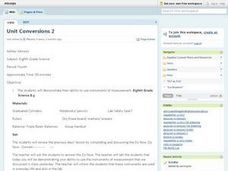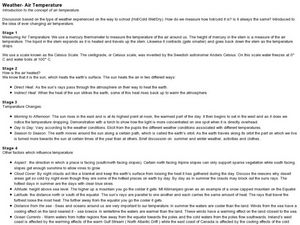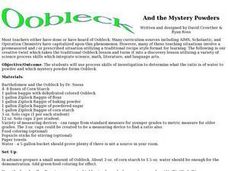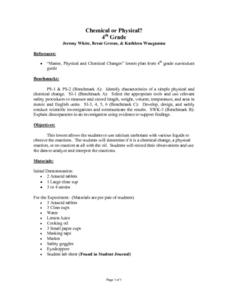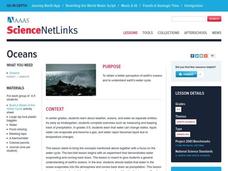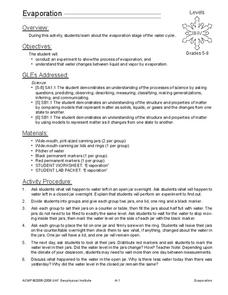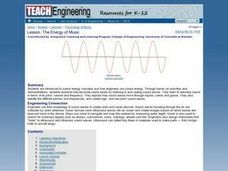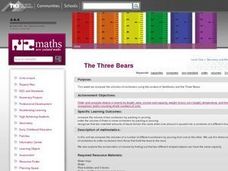Curated OER
The Nature Of Dissolving Processes
Students examine the rule of "like dissolves like." They define and describe solutions and solubility models on molecular liquids, ionic solids, and molecular solids.
Curated OER
Density Lab Activities
Young scholars participate in several density lab activities in order to clarify the misconceptions that solids sink and liquids float. Students work with triple beam balances to find mass of objects to calculate density.
Curated OER
Unit Conversions 2
Eighth graders demonstrate the use of instruments of measurement. As a class, they take notes and observe the proper procedure for using a graduated cylinder, a ruler, and a balance/triple beam balance. In groups, 8th graders visit...
Curated OER
How to Read a Thermometer
Students' temperature is measured using an instrument called a thermometer.
Curated OER
Weather-Air Temperature
Students complete activities to learn about changing air temperature. In this air temperature instructional activity, students study various ways to measure air temperature and learn factors that influence temperature. Students study the...
Curated OER
Density and Buoyancy Lesson Plan
Students investigate why some objects float or sink in water. In this physics activity, students calculate the density of clay ball using a mathematical equation. They write a complete lab report about the experiment.
Curated OER
Oobleck and the Mystery Powders
Pupils listen to the book, "Oobleck," by Dr. Suess before experimenting with mystery powders. They determine the proper ratio of powder to liquid to make the Oobleck.
Curated OER
Paper Packaging Design
Students create packages with a maximum capacity. In this geometry activity ,students estimate using whole numbers, decimals and fractions. They calculate length, weight and mass of packaging.
Curated OER
The Grouchy Ladybug
Students complete a Cirlce Map about time. They recall times during the grouchy ladybugs travels, and add dots on ladybugs using turn-around facts. Pupils correctly sequence the events of The Grouchy Ladybug. Students compose new...
Curated OER
Chemical or Physical?
Fourth graders make observations of the reactions that happens between calcium carbonate and various liquids. During the experiment the students determine if there is a chemical change, a physical reaction, or no reaction when they mix...
Curated OER
Fertilizers, Pesticides and Health
Students apply real data to create and calculate algebraic equations. Students create a visual to represent the concentration for one part per million and apply unit analysis to verify measurement computations. Students define the use...
Curated OER
Investigation 3 - Condensation Chambers
Fourth graders investigate the concept of condensation and how it is formed. They conduct an experiment and make observations of the chambers. Students record the data and then write down conclusions. The instructional activity includes...
Curated OER
Pyramids on Parade/Nets
Students sketch the shape of three dimensional pyramids using nets. In this geometry lesson, students differentiate a pyramid from other three dimensional shape. They define the attributes of pyramids.
Curated OER
Oceans
Students use their prior knowledge to being their examination of the water cycle. In groups, they complete an experiment in which they can see water evaporating and coming back to the ground. They discover the ocean's water evaporates...
Curated OER
Evaporation
Students study the evaporation stage of the water cycle. In this water cycle lesson, students participate in an experiment to study the process of evaporation that uses jars and water. Students complete an observation worksheet for...
Curated OER
Coastal Threat: A Story in Unit Conversions
Students convert measurements from one unit to another. In this math lesson, students study the environmental consequences of oil spills. They replicate an oil spill event by modeling and scaling.
Curated OER
Determining The pH Of Common Substances
Students use a pH indicator to measure the pH of some fruits, common beverages, and borax. Students discover how to differentiate between an object that is an acid or a base.
Curated OER
The Energy of Music
Students discover how engineers use sound energy. They participate in hands-on activities in which they discover how we know sound exists. They identify different pitches and frequencies as well.
Curated OER
Geometry: Practical Applications of the Distance Formula
Students, working independently and in groups, apply the distance formula to practical situations. After solving various problems, students in pairs design coordinate planes from the school blue print to measure the distance from the...
Curated OER
The Three Bears: Comparing and Ordering
Students explore comparing and ordering volume of containers. They use the context of Goldilocks and the Three Bears to compare the volume of various containers by packing or pouring.
Curated OER
Buoyant Force
Students investigate the scientific concept of why some objects float when put in a liquid solution. They apply the laws of motion and force while conducting classroom activities. Students also take notes and answer target questions to...
Curated OER
Water and Ice: Part 1
Students observe the state changes in water. In this matter lesson, students observe, measure, and describe water as it changes state. Students explore how water can change from a solid to a liquid then back again. They journal their...
Curated OER
Glurch II
Students make glurch using materials provided. In this chemistry activity, students identify the physical properties of glurch. They compare its properties to commercially prepared ones.
Curated OER
Light and Shadows
Students observe and record the apperacne of shadows and how their position and shpae changes during the course of the day. Students measure and record the length oof a partner's shadow at different intervals during the day. In pairs,...


